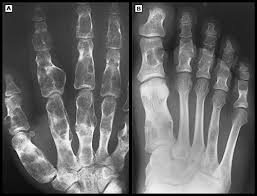
Enchondromatosis, also known as Ollier’s disease, is a rare genetic disorder characterized by the presence of multiple enchondromas, which are benign cartilage tumours that grow within the bones. Enchondromatosis can affect any bone in the body, but it is most commonly found in the long bones of the arms and legs, as well as in the bones of the hands and feet.
The exact cause of enchondromatosis is not fully understood, but it is thought to be caused by mutations in certain genes that control the growth and development of bone and cartilage. The condition can be inherited in an autosomal dominant pattern, meaning that a person only needs to inherit one copy of the mutated gene from a parent to develop the condition.
Symptoms of enchondromatosis can vary widely depending on the location and size of the tumours. Some people with the condition may have no symptoms, while others may experience pain, deformity, and an increased risk of fractures.
Treatment for enchondromatosis typically involves close monitoring of the tumours with regular imaging studies, such as X-rays or MRIs. Surgical intervention may be necessary if the tumours are causing pain or are at risk of fracture, and may involve procedures such as curettage (removal of the tumour), bone grafting (replacement of the removed bone with healthy bone), or amputation in severe cases.
It is important to consult with a healthcare provider if you have been diagnosed with enchondromatosis or have a family history of the condition. A healthcare provider can help to develop an appropriate course of treatment and provide guidance and support for managing the condition over time.
